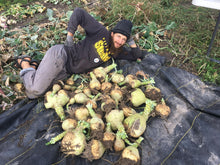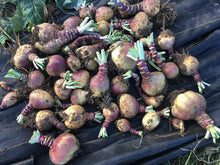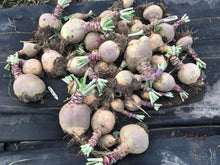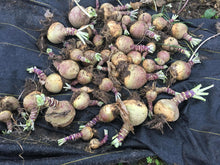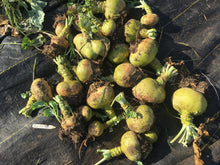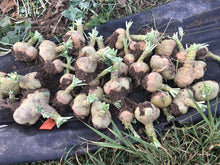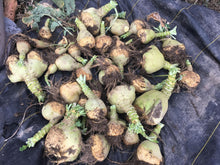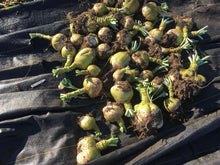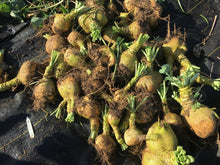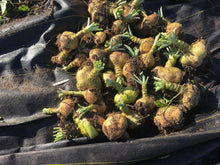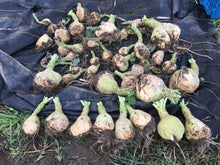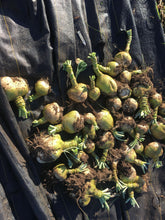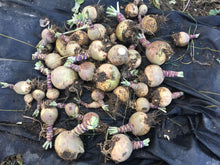'Rutabangin' Rutabaga Grex
Regular price
$4.25
Sale
Brassica napus napobrassica
Origin: Milaca, MN via Europe, Russia, USA
Improvement status: Grex
Seeds per packet: ~150
Germination tested 12/2025: 95%
Life cycle: Biennial
We consider rutabagas to be a highly underappreciated and underutilized crop. For a few years, Clint Freund (our friend and colleague and co-founder of Cultivating the Commons) and Dusty had been dreaming up a super-diverse rutabaga population to encourage more breeders to work on this super cold-hardy, nutritious, long-storing crop. The idea was to get all the rutabaga varieties they could find and grow them together. Finally, in 2020, they did just that. Varieties were sourced from other seed companies, seed swaps, the USDA's National Plant Germplasm System, and Nate (who provided 'Miss Gladys McGee's Turnip', a rare heirloom rutabaga from far northern New York state'). The top plants rom the best performing varieties were saved, and this select group then inter-pollinated with each other in 2021 when they flowered. They definitely were happy in the heavy clay soil of Milaca, Minnesota.
Why are we so into rutabagas? As utilitarian homesteaders, we love calorie-dense crops. It's great in winter soups, roasted root vegetable mixes, or curries. Dusty's favorite way to prepare it is simply boiled and mashed in a 50/50 mix with potatoes. Add some salt, pepper, butter, or olive oil... Mmm! You won't be disappointed.
For a crop that gets such little love from plant breeders, this was a really interesting trial. We saw so many diverging charactestics among the plants: different colors, shapes, sizes, stem types, and leaves. There was quite a bit of variation in how much of a canopy they create too (important for weed supression). Being the same composite species as some of our favorite kales (Brassica napus, believed to be the result of a long-ago cross between a turnip and a cabbage), the leaves of rutabagas are really tasty too, and someone could certainly use this grex to develop rutabagas with especially delicious leaves.
This is a very raw grex (diverse interbreeding population). We started with 14 different varieties. The two worst performing varieties were cut completely. Then we picked the top performing eight plants from the remaining twelve varieties and crossed them together. We plan to keep working on this one over the coming years, but we wanted to get it out to you as soon as possible so you all can have as much fun as we're having, and hopefully pretty soon we'll all start cranking out new rutabaga varieties!
Varieties in the population:
Nadmorska - A green-topped Lithuanian variety introduced by Adaptive Seeds. Very little neck and with a nice mustardy flavor.
Bergins - Clint got this variety from entomologist and plant breeder Munk Bergin (of Oregon and Hawaii), well known in seed circles for his northern-adapted high anthocyanin purple corn, 'Soltera Morado.'
American Purple Top - The most common rutabaga variety today and probably the oldest US variety, it likely comes from the original "Purple Top" rutabaga strain from Bohemia in the 1600s.
Joan - Said to be a "refined" selection of American Purple Top, Joan was developed in Wales to tolerate damp soils and cold, wet weather. It's uniform and delicious.
Major Dunne (or Doon Major) - Another variety from Adaptive Seeds, collected by their Seed Ambassadors Project from the Irish Seed Savers. Once a commercial variety in Northern Ireland, it's said to originate in Scotland. Smooth, slender, purple-topped, and well-flavored.
Miss Gladys McGee's Turnip - A long-green-and-purple-necked rutabaga cultivar capable of reaching extremely large sizes (25 pounds!) without its mild-flavored white flesh getting woody. Nate was given seeds by Bill MacKently (seen here holding a "medium-sized" ten or twelve pounder) at St. Lawrence Nurseries in Potsdam, NY, where it's a beloved local heirloom. It was rescued in the form of a single plant that survived a winter outdoors by a neighbor of the late Gladys McGee after she passed.
USDA seed bank varieties:
PI #: 632742
Cultivar name: 'BRA 1042/95'
Origin: Bażanówka, Poland
Year collected: 1978
PI #: 632739
Cultivar name: 'Oana'
Origin: Unknown
Year donated to USDA: 1996 (from Germany)
PI #: 632740
Cultivar name: 'Östgöta'
Origin: Sweden
Year donated to USDA: 1996 (from Germany)
PI #: 632738
Cultivar name: 'Niko'
Origin: Unknown
Year donated to USDA: 1996 (from Germany)
PI #: 632741
Cultivar name: 'Pastewna Zolta' ("yellow fodder")
Origin: Poland
Year donated to USDA: 1996 (from Germany)
PI #: 263056
Cultivar name: 'Donnuvos Bal'ten'
Origin: Lithuania
Year donated to USDA: 1960 (from the Soviet Union's NI Vavilov Research Institute for Plant Industry, Leningrad)
PI #: 406309
Cultivar name: 'Vysegorodskaja Ulac Sennaja' (or Vysegorodskaja ulucsennaja)
Origin: Moscow region
Year collected: 1975 (from the Soviet Union's NI Vavilov Research Institute for Plant Industry, Leningrad)
GROWING TIPS: Rutabagas take their time to develop, so in a northern climate it's best to transplant healthy starts in May or early June. You may be able to get away with direct seeding, depending on where you are. We recommend rows 14-20 inches apart, with plants around 8-10 inches apart. Harvest in fall when they've properly sized up.
SEED SAVING: Rutabagas are biennial, so they need to grow a full season, over-winter, then go to seed the following spring. From our experience, Brassica napus can be a very cold-hardy species (we have seen napus kales overwinter in Minnesota). There is a good chance your rutabagas will overwinter right in the field, especially in more southerly places, though animal pests might enjoy them as a late winter snack. For most reliable results, it's best to dig them up and keep them in cold storage through the winter. We keep them just above freezing in a cooler in damp sand. A root cellar would work great, or in a pinch a cool garage or even a fridge. Plant outside the following spring as soon as the soil can be worked.














